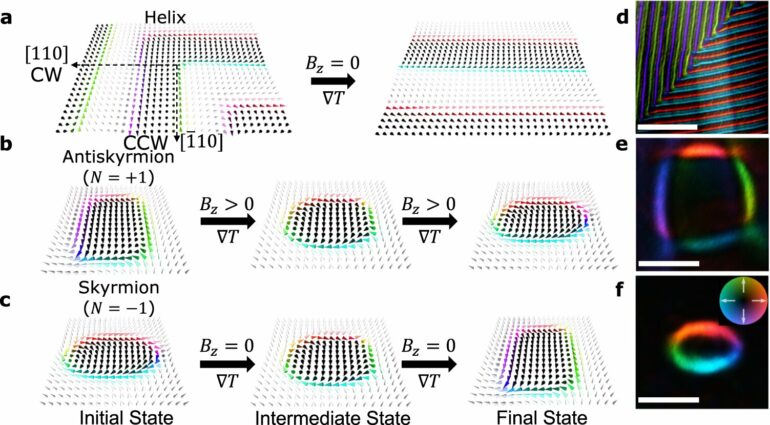In an experiment that could help the development of new spintronics devices with low energy consumption, researchers from RIKEN and collaborators have used heat and magnetic fields to create transformations between spin textures—magnetic vortices and antivortices known as skyrmions and antiskyrmions—in a single crystal thin plate device. Importantly, they achieved this at room temperature.
Skyrmions and antiskyrmions, which are textures that exist within special magnetic materials involving the spin of the electrons in the material, are an active area of research, as they could be used for next-generation memory devices, for example, with skyrmions acting as a “1” bit and antiskyrmions a “0” bit.
In the past, scientists have been able to move them in a variety of ways, and to create transformations between them using electric current. However, because current electronic devices consume electrical power and produce waste heat, the researchers in the group, led by Xiuzhen Yu at the RIKEN Center for Emergent Matter Science, decided to see if they could find a way to create the transformations using heat gradients.
According to Yu, “As approximately two-thirds of the energy produced by power plants, automobiles, incinerators, and factories is wasted as heat, we thought it would be important to try to create transformations between skyrmions and antiskyrimions—which has previously been done using electric current—using heat.”
To perform the research, now published in Nature Communications, the researchers used a focused-ion beam—an extremely precise fabrication system—to create a microdevice from the bulk single crystal magnet (Fe0.63Ni0.3Pd0.07)3P, composed of iron, nickel, palladium, and phosphorous atoms, and then used Lorentz scanning microscopy—an advanced method for examining the magnetic properties of materials at very small scales.
What they found is that when a temperature gradient was applied to the crystal simultaneously with a magnetic field, at room temperature, the antiskyrmions within it transformed first into non-topological bubbles—a sort of transition state between skyrmions and antiskyrmions—and then to skyrmions, as the temperature gradient was raised. They then remained in stable configuration as skyrmions even when the thermal gradient was eliminated.
This was a finding consistent with theoretical expectations, but a second finding surprised the group. According to Fehmi Sami Yasin, a postdoctoral researcher in Yu’s group, “We were surprised to also find that when the magnetic field was not applied, the thermal gradient led to a transformation from skyrmions to antiskyrmions, which also remained stable within the material.”
“What is very exciting about this,” he continues, “is that this means we could use a thermal gradient—basically using waste heat—to drive a transformation between skyrmions and antiskyrmions, depending on whether a magnetic field is applied or not. It is particularly significant that we were able to do this at room temperature. This could open the way to a new type of information storage devices such as nonvolatile memory devices using waste heat.”
According to Yu, “We are very excited about his finding, and plan to continue our work to manipulate skyrmions and antiskyrmions in new and more efficient ways, including the thermal control of antiskyrmion motion, with the goal to build actual thermospintronic and other spintronics devices that could be used in our everyday lives. To make better devices we need to thoroughly explore various device designs and geometries.”
More information:
Fehmi Sami Yasin et al, Heat current-driven topological spin texture transformations and helical q-vector switching, Nature Communications (2023). DOI: 10.1038/s41467-023-42846-7
Citation:
Scientists use heat to create transformations between skyrmions and antiskyrmions (2024, January 12)



